VISITING LAPLAND WITH MY NEW FRIENDS FROM CONGO, SUDAN, BURMA, IRAN & MOROCCO
DAY ONE – LES PETITS HOMMES
- Les petits hommes? - Where are the little people? – I haven't seen any yet.
Jean, a Congolese man asks Maiju in French, in earnest. Maiju looks at me while translating the question. We wonder if he's talking about the Sami or 'the little people' known to live in Lapland. I tell him in Finnish to keep looking. You never know when one appears.
We're hiking on the Paljakka Fell in Finnish Lapland. After a 12-hour bus ride from Jyväskylä to the Eastern part of Lapland, familiar to Rafu and me from our ski trip in the spring, the hiking group changed into proper gear, packed the backpacks and took off. We thought we would hike 9 km to set up camp, but found out a day later that we had actually managed 15. The scenery was very different from anything we had ever experienced. We passed the tree line on the tundra-like terrain and hiked up a slowly ascending hill, called tunturi, a fell. There were areas of slippery snow and long stretches of rocks of various shapes that made walking slow and tedious. Nothing seemed to stop the four Burmese among our group, though. They requested the rest of us to speed up.
–No way - we told them, asking for an explanation for their ease.
– Just like the terrain in Northern Burma, near Chinese border.
From then on, they were nicknamed the Burmese guerrillas.
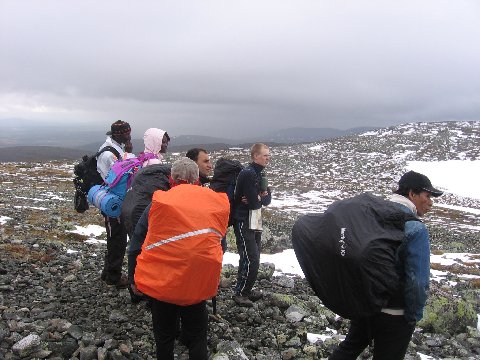
Looking for Les Petits Hommes
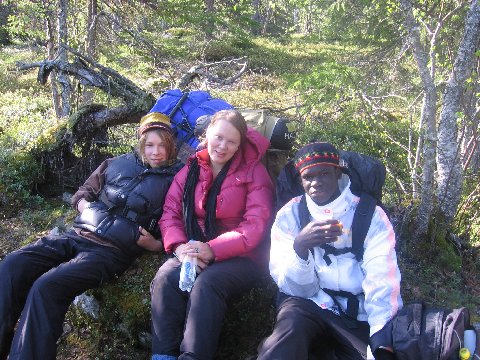
- finally - a break!
We finally made it to the hut that could accommodate a few of us. The rest of us set up tents on the sloping, rocky hill close to midnight. But the hour of the day hardly matters. The sun doesn't set at all, so night hiking is fine. Matti, our leader, started to prepare dinner.
– Who's got the cheese? Who's got the sausages to be roasted on the campfire?
It turned out the bus refrigerator had got it all. We started laughing . . . too tired to care. When Matti announced that he couldn't find the teabags, we laughed some more and happily drank hot water with sugar and ate bread toasted on the grill. The Burmese had carried the bread . . . all eight loaves of it! - We all knew what would be for breakfast.
DAY TWO – TRAVELING UP THE ARM
We woke up at 6 AM, had our bread and water and hiked back another route, A mere 6-7 kilometers. A hotel sauna and plentiful breakfast awaited us when we marched into the yard, singing. The song was written en route and obviously included a verse on the missing sausage and cheese.
After boarding everyone onto the bus – a major task - we drove another 200 km up the arm of The Maiden of Finland. If you look at the map of Finland, you'll notice she's shaped like a maiden. Her right arm is missing, and her skirt on the right is cut off – due to the peace treaty with the Soviet Union after the Continuation War, September 1944. Finland had to cede all of Petsamo, by the Arctic Ocean, the Karelian Isthmus, between the Gulf of Finland and Lake Ladoga, and territories to the West and North of Ladoga and lease some other territories. Together with Salla and Petsamo, islands and leased territories, Finland had to cede 43,491 square kilometers to the Soviet Union. That represented nearly 12.5 per cent of the country – an area larger than all Denmark.
The scenery might be monotonous, but the bus ride is quite the opposite. Our group includes 14 Sudanese, 24 Congolese, four Burmese and one Kurd. There is a main leader, Kutti with her 11-year-old daughter and four assistant leaders: four Finns, one Moroccan, and myself, a volunteer, and my California-born children, Maiju and Rafael. We make a lively scene. The largest family is Congolese, 11 of them from 11-moth-old Isaac to 75-year-old diabetic grandma, Veronique. There are other toddlers, Isaac's uncle, 16-month-old Jean-Pierre, one-year-old Sarah, and a two year-old Ester. They become communal children, being passed from one set of arms to another, and another . . . tenderly cared for.
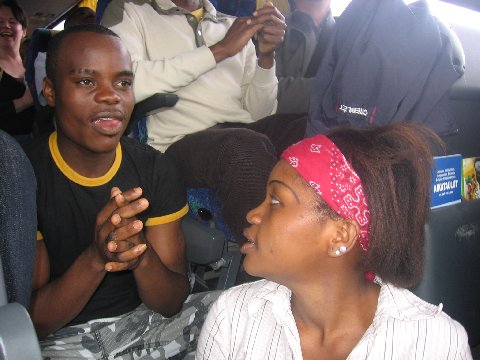
Performing on the bus
One of my favorite scenes occurred on the ride to Kilpisjärvi, up the arm. We stopped at a war museum, commemorating the Lapland war – which occurred when Finns, who had invited Germany to help, had to ask them to leave based on the 1944 Peace Treaty with the Soviet Union. In retaliation Germany burned down the entire Finnish Lapland. What was truly amusing during this serious visit: our group was standing in the trenches while the guide and the four interpreters stood on a gorgeous hill, all interpreting at the same time. It was a true tower of Babel moment as people tried to distinguish their native language from the mixture of Swahili, French, Arabic or Burmese. The museum was a moving experience as the refugees saw a new side of Finland that had so far shown her well-off, well-designed, well-to-do side. The refugees had many questions about the suffering Finns had gone through – and about their new home country that has been built up from the ashes, to their great surprise.
We arrived at a cabin village by the Lake Kilpisjärvi and the second tallest fell in Finland, SaanaTunturi. We settled in comfortable, beautiful cabins, had dinner and gathered at a Kota, a large Sami tepee for a night of dance, song and laughter.
DAY THREE – FREEZING AT THE ARCTIC OCEAN, CONQUERING THE MIGHTY SAANA - & SEEING JESUS?
The third day took us abroad. Many Congolese had asked about crossing the boarder since we were driving up one side of River Tornio, looking at the other side, Sweden. It was hard for them to believe that no one would really care if we crossed to Sweden or Norway. This was proven true on our trip to the Arctic Ocean, in Norway. There didn't seem to be any officials at the boarder station, but then we did see a wave and a smile from both a Finnish and Norwegian border guard. Our refugees, who had gone through incredible suffering and sacrifices crossing other borders in their lives, just shook their heads in disbelief.
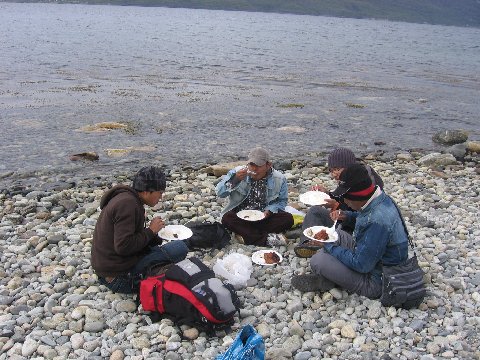
Burmese lunch at the Arctic Ocean
After a cool, gray day in lush, green Norway – effects of the Gulf Stream, we returned to Finland for dinner. The sun suddenly brightened the evening sky, and a quick decision was made to climb Saana that night. Young and old, about 40 of us, climbed the Saana Fell for four hours. It was windy, but bright on top. We got to record our names in a book, kept in a metal box at the peak, and admire the scenery all around us. The Norwegian mountains looked majestic, still covered in snow, the Swedish ones resembled more the fells on the Finnish side. The special yellow structure marking the border between Finland, Sweden and Norway, was hidden in between fells, maybe ten kilometers away. We made it back to our cabins by 10:30 PM, in the bright 'daylight', had a sauna – and slept tight!
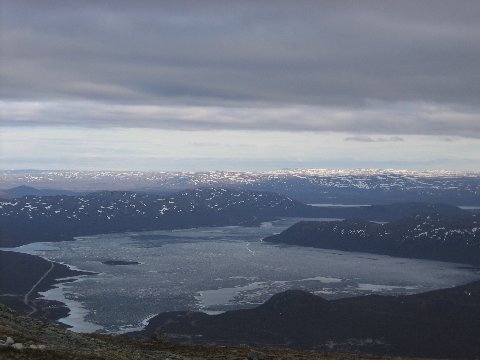
A view showing Finland, Sweden and Norway as seen from the mighty Saana
In the evening, in our cottage, Totti, 13, impressed at Maiju's climbing the Saana, looked her in the eyes and asked a straight question with a glimmer in his eye,
-Well, did you see Jesus?
-Where?
-Up on the Saana, you were so close to taivas. (taivas = heaven and sky, in Finnish).
When Maiju shook her head, Totti further advised Maiju:
-You should have reached up to catch Jesus' hand. Maybe he would have let down a ladder, and you could have had a sneak preview of heaven.
Then Totti's younger sister Glody chimed in:
-Yeah, but it would have been pretty bad if you had pulled Jesus' foot instead - it's a big place - heaven is; maybe it was better that you didn't even try!
Maiju agreed with a laugh.
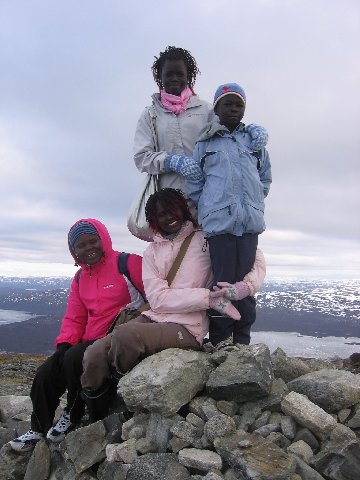
The Sudanese occupation of Saana
DAY FOUR –VISITING REINDEER & - EATING SOME, TOO!
Everyone was excited about the visit to a reindeer farm. We had time to stop by in the local Nature Museum where we learned about the natural wonders of Lapland and the Aurora Borealis. The walk was slow, the pace set by grandma Veronique with her walker. After the museum, a reindeer herder, Juha, told stories of his profession in a large Kota, where we sat on benches covered by reindeer skin. Maiju and I glanced at Jean when Juha's stories turned to Maahiset, little people or les petits hommes. Finally, some 'facts' delivered. Juha ended the Kota time with a yoking performance. Then everyone got to throw suopunki, a lasso, used catching reindeer by the horns at the annual Poroerottelu, Reindeer Separation. We walked back to enjoy a dinner of – guess what? Sautéed reindeer with mashed potatoes and lingonberry sauce – a Lapland specialty.
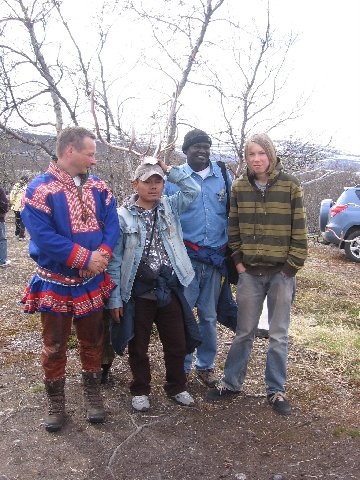
Men from four nations: a Sami, a Burmese, a Congolese, and a California Finn
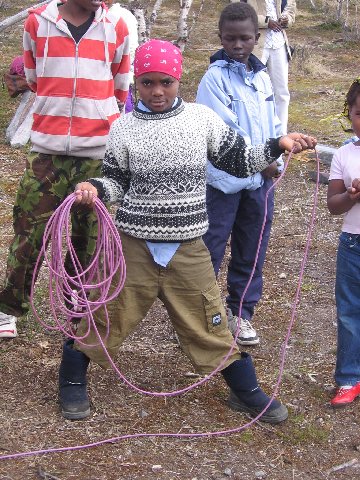
Totti practicing lassoing a reindeer
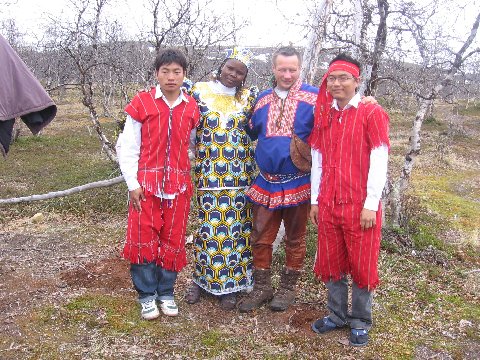
National costumes are colorful everywhere
Since this was the last night before a 7 AM departure, we spent it in our 'own' Kota, singing, dancing and making crepes over the open fire. Pastor Raimo, one of the leaders, shared his happiness of the African drumming and singing. Having spent 10 years in Senegal with his family he appreciated the 'back at home' feeling of joy and community. The Burmese guys joined in with a guitar and song, and we also poems, recited in Kurdish. In the end, we all joined in a song in Finnish and Arabic and closed the night in prayer.
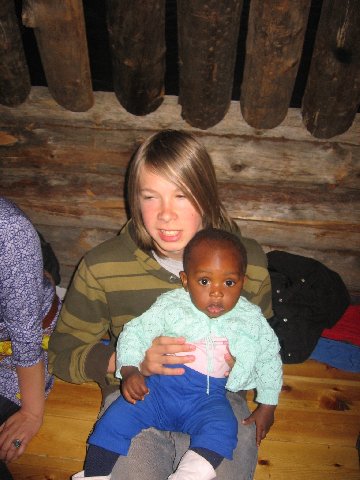
Everybody loves Isaac
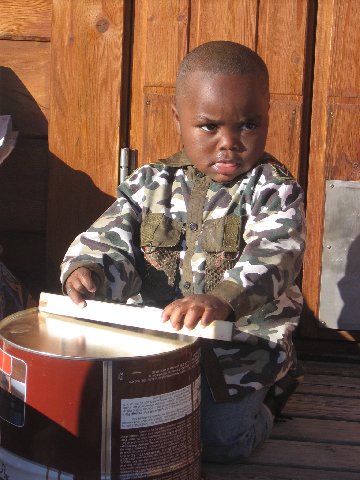
DAY FIVE - JOULUPUKKI, HABIBI & AU REVOIR
Trying to get all 53 of us in the bus is a miracle. This time, at 7 AM, it involved stuffing the bottom of the bus with baby strollers, hiking gear and suitcases. When the doors close, there's always the electric moment of counting heads. Did anyone manage to hide behind the Kota, in one of the saunas, at the rushing river nearby, etc. All were counted in, and we took off, waving good bye to our hostesses. We had been driving about 15 km. when, to everyone's horror, a reindeer leaped onto the road on a whim and was hit by the bus, dying immediately. We all felt sad; it might well have been one of Juha's reindeer. A call to the local authorities took care of what we learned was a fairly common occurrence, and we continued in silence.
But Kutti, our able boss, had a more pleasant surprise waiting – a visit to the Arctic Circle in Rovaniemi where the real Santa Claus, Joulupukki, keeps his official tourist quarters. He actually lives in Korvatunturi, the Ear Fell, an ear-shaped fell in Eastern Lapland - but that is off limits to everyon but the elves. Joulupukki has chosen the fell for its ear-shape, so that he can listen to all the children in the world when they whisper their Christmas wishes to him. A very exotic-looking group photo with Joulupukki was taken, souvenirs bought, and snacks eaten before we piled back on the bus.
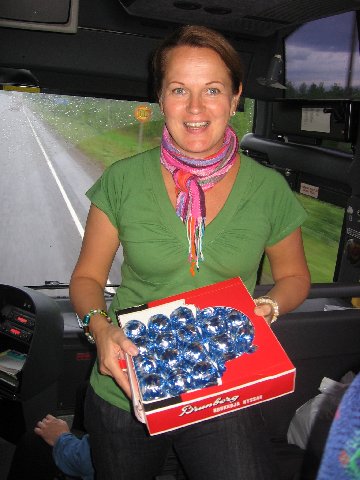
Our sweet leader,Kutti, with final goodies: Brunberg's kisses for all!
After seventeen hours on the road with many stops, quizzes, multilingual singing, and dancing to our theme song, Habibi, in Arabic, we pulled into our first stop in Jyväskylä. The same scene of hugs and kisses, sleeping babies placed in strollers, bags pulled and happy but tired smiles was repeated four times before reaching our final destination, the main parish building in the center. It was one in the morning when I tiptoed into my friend's apartment to fall into a deep sleep. But it took me several days to be back on terra firma . . . the experience was so joyful and amazing that I felt lifted off firm ground for days.
. . . next year - in Kilpisjärvi . . .
Kommentit